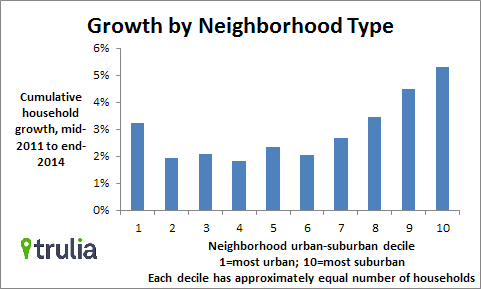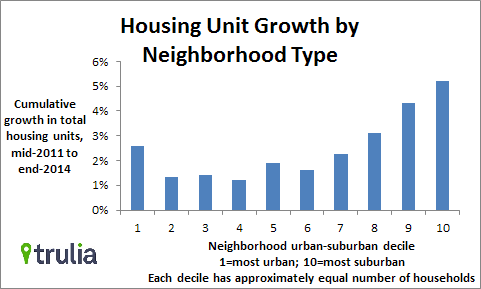A few weeks ago, the Wall Street Journal reported on a new study by the National Association of Home Builders which found just 10 percent of people born after 1977 want to live in the urban core; the rest want the suburbs or rural areas. The catch was that the study group was only those who had bought a house in the past three years or who plan to do so. In other words, people who want to buy a house want to live in a place where they can buy a house. But the study, an exercise in tautology if there ever was one, does add some value to the overall discussion about what today’s young homebuyers want out of a home, and the reaction to the study shines light on the foolishness of urban-vs-suburban partisanship.
What the study says
Just 10 percent of young homebuyers want to stay in the central city, while 68 percent want to move to the suburbs. These suburban homebuyers tend to buy smaller, older houses relatively close to the central city, and they put a premium on being within walking distance of amenities like restaurants, stores, schools, and transit.
This is not the typical car-oriented suburb. Rather, it’s a suburban town, the sort of place that grew up along the old streetcar lines before they vanished. It’s a place that can accommodate trips made by car, transit, biking, and walking.
It seems the same things that draw young people to cities remain valuable even when those same young people leave.
What the study leaves out
The NAHB study is a stated-preference study. In other words, it looked at what people said they wanted rather than what they actually did when presented with options, which is called a revealed preference study.
This is most clear in the disconnect between the cost of housing in a dense, walkable urban place and the cost of housing in a sprawling, drivable place. Outer-suburban and exurban homes were the first to lose their value during the Great Recession and have been the slowest to recover. Meanwhile, dense, central cities have seen the cost of housing soar, as have walkable towns near those cities.
These price signals are quite clear: the supply for outer-suburban and exurban homes exceeds demand, and the demand for central-city homes exceeds supply. Similar price stability and price spikes along transit corridors and in the old walkable streetcar suburbs shows this demand isn’t simply for central city homes but for walkable living.
More than that, the study doesn’t scratch the surface of where young people would want to live if central cities had similar prices and similar school quality to the suburbs. After all, the draw of the suburb might not even be a function of the suburban or urban form per se but a simple function of how inhospitable American cities are to raising a family.
Or perhaps it’s simply housing availability: most new housing development has been in the exurbs, and central cities have been housing laggards.
This last theory is held out by analysis by Jed Kolko of real estate analyst Trulia. Last week, he tweeted the following three charts:
Growth in population closely matches the growth in housing units across the urban spectrum: the more homes, the more people. In fact, a read of the last two charts shows that neighborhoods are adding households faster than homes in all but the most suburban neighborhoods (deciles 9 and 10), with the most pronounced difference in urban neighborhoods (deciles 2-4). As a result, the growth in home sale price is highest outside of the most suburban neighborhoods. While the most urban neighborhoods saw their prices go up fastest, it was the least urban neighborhoods that saw their housing supply and population rise fastest.
This is due to a number of factors, but the largest is the $400 billion worth of federal subsidies (PDF) poured into the most suburban of places. Given the price rises in more urban areas, it seems as though this and state-level policies are working against the underlying demand rather than chasing demand.
It’s a stupid debate
Anti-urban partisans are always quick to crow about the end of the cities and seem eager to pounce all over any shred of evidence that might support this thesis, context be damned. Anti-suburban partisans, alas, do the same about evidence for suburban demise.
Yet being a partisan for a particular kind of urban form is nonsense. The great structural debate about housing and transit in the United States is fundamentally about whether the provision of housing in all its forms has adequately satisfied consumer demand.
The NAHB study doesn’t presage the slaughter of the city and triumph of the suburb any more than the fact that Americans aren’t driving as much presages the opposite. It presents a look at where young homebuyers say they want to live (namely, in places where they can buy homes).
What does this mean for Marin?
Young people want places that look like Marin: walkable, suburban, not too far from the city, with a decent transit network. Consumer demand surveys of all young people, not just homebuyers, found that the strong bias towards walkable living is found among renters and homebuyers alike.
The problem, of course, is that there isn’t enough San Francisco, or Marin, to go around. As I have insisted since the beginning of this blog, the demand for new homes in Marin should be channeled into enhancing and spatially expanding our downtowns.
San Anselmo, for example, has space for 79 of new apartments above stores within its downtown core. That’s 79 new families that could be living and shopping in a totally walkable environment. If downtown zoning were expanded to highway commercial zones, that’s room for dozens more new families and businesses.
Marin could push against its own struggling town centers and try to hem them in, or it could take this as an opportunity to build upon the formula that works: walkable towns adjacent to nature. There is room enough for the entire spectrum of suburban home types in Marin. We can take advantage of that demand, and build a greater Marin out of it.


